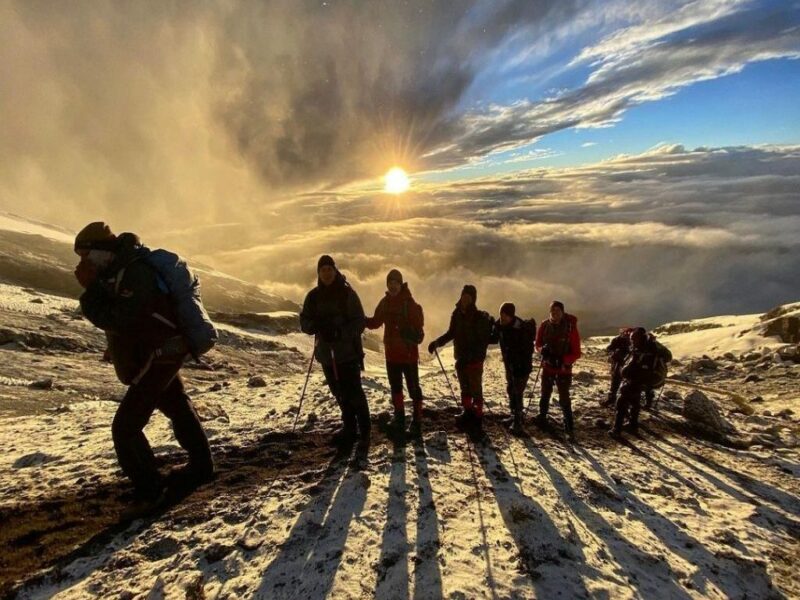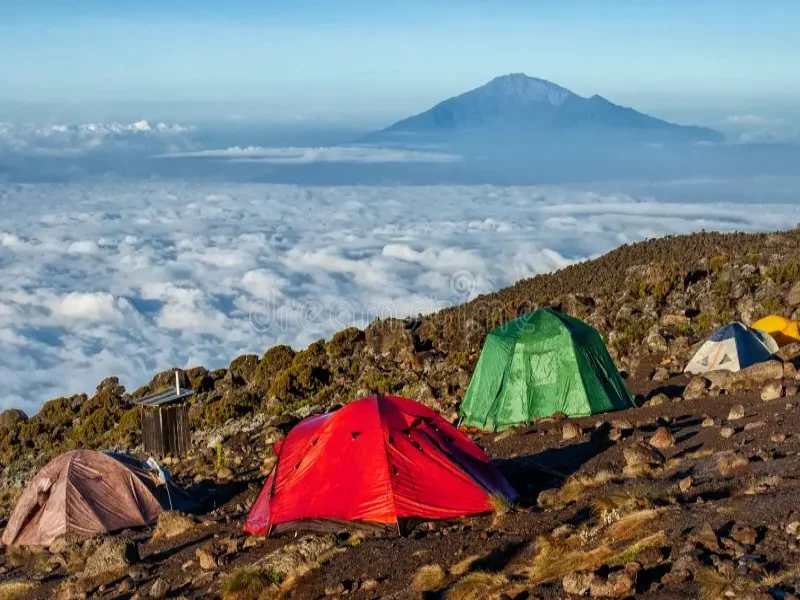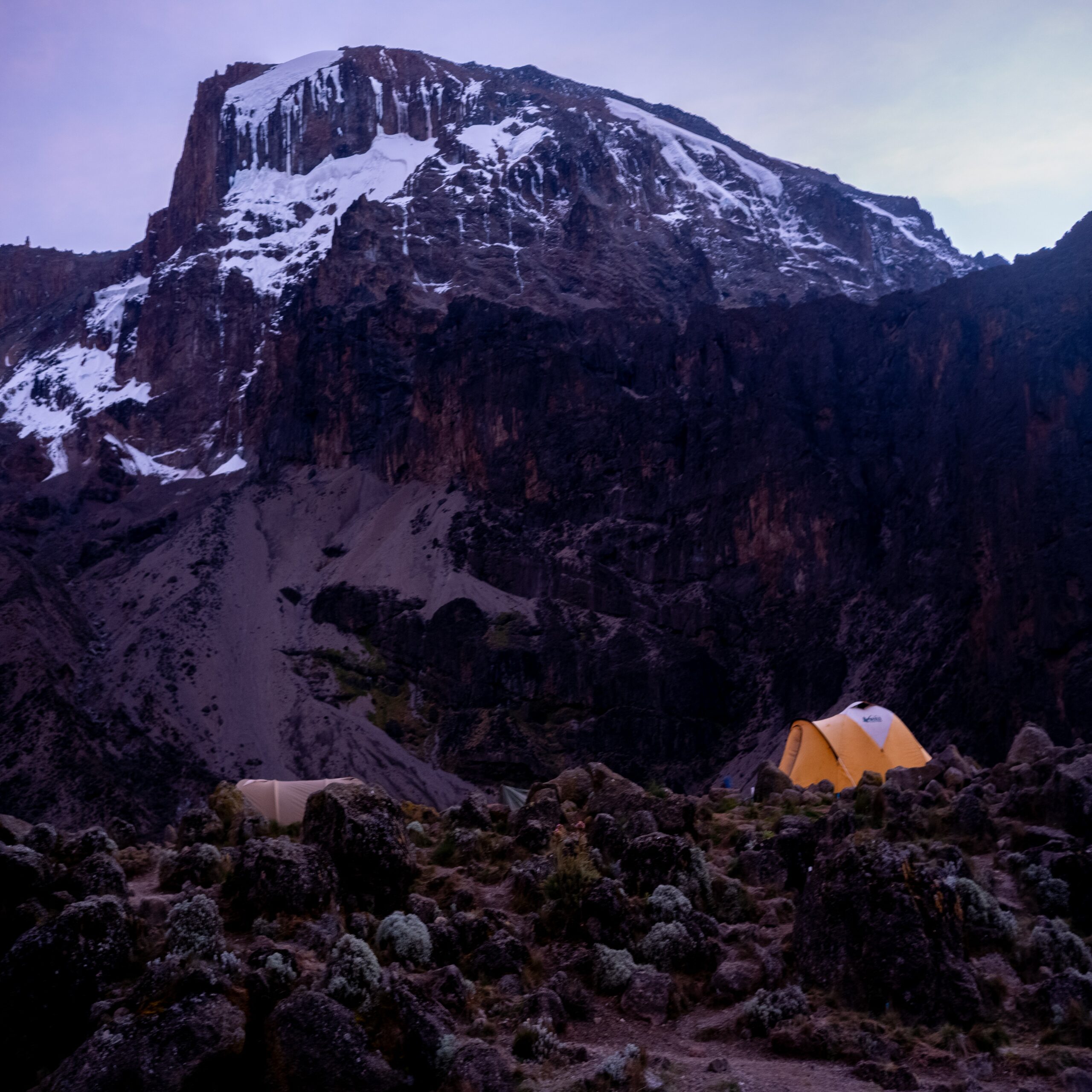Mount Kilimanjaro is the highest mountain in Africa, standing tall at 5,892m, and is one of the Seven Summits, the other six comprising of;
Mt Everest – Nepal/China 8848m
Aconcagua – Argentina 6962m
Denali – Alaska 6194m
Mt Elbrus – Russia 5642m
Vinson Massif – Antartica 4892m
Mt Kosciuszko – Australia 2228m
Kilimanjaro is said to be the easiest of the 7 Summits, as no technical skills or equipment, like ropes, harnesses, crampons or ice axes are required. It is a ‘hiking’ or ‘walk up’ peak and not a mountaineering or climbing peak. This makes it very popular with first time adventurers as well as experienced hikers.
It is also the world’s tallest free standing mountain, and most likely was created as a result of volcanic activity where molten rocks erupt and pile upon the surface.
Although Mount Kilimanjaro lies 205 miles from the equator, it has glaciers covering its summits, which shrink and regrow during the planet’s ice ages.
The mountain once had 3 distinct volcanic cones – Kibo, Shira and Mawenzi.
KIBO – this is the tallest cone as well as the central one and is where the summit lies
MAWENZI – this is a craggy peak raking 3rd highest in Africa (after Kibo and Mt Kenya), and you can get great views of this peak from the Rongai and Northern Circuit routes.
SHIRA – this is no longer a peak but was estimated to have been at a height of 4876m before it collapsed. It has now created the Shira Plateau on the western side of the mountain, and the Machame, Lemosho and Shira routes cross this plateau.
Kibo is considered a dormant volcano (the last eruption occurred 200,000 years ago) while both Shira and Mawenzi are extinct.
The first successful attempt on Kili was made in 1889 by Hans Meyer, a German geologist, together with Ludwig Purtscheller, an Austrian climber, accompanied by their local guide, Kinyala Lauwo.
The main routes to climb Kili are:
Machame
Also known as the ‘Whisky Route’, this is the most popular camping route. It is done in 6 days and can be challenging due to the altitude and fairly short acclimatization period. It does require both mental and physical strength to complete the challenge. It is a very scenic and rugged route.
Rongai
The initial approach on this route is from the dry northeast, up the flanks of Mawenzi, crossing the saddle to Kibo, then joining the Marangu route to the summit.
Lemosho
This is the longest route, taking 7 days or more. It begins at a remote trailhead, where vehicles find it difficult to get to in the rainy season, so climbers have to begin their trek on a muddy 4×4 trek (rainy season is April/May and Nov/Dec). It crosses the Shira Plateau and then you have the option to continue towards the summit, using either the Southern Circuit (most popular) or the Northern Circuit (this will give you a complete transverse from west to east over Kili). This route can get busy, especially during weekend start dates, and as the first camp is small, it can feel crowded.
Umbwe
The shortest and most direct way to the summit, this route is most challenging, in terms of terrain and grade.
Marangu
Called the ‘Coca Cola’ route, this is the original hut route. Best done in 6 days. It ascends from the southeast, crosses the saddle between Mawenzi and Kibo and goes upto Gillman’s Point, before approaching the summit at Uhuru Peak, from the south crater rim.

Rongai
This route flanks the Mawenzi, crossing the saddle to Kibo and joins the Marangu route to the summit.
It is estimated that approximately 30,000 climbers attempt to climb Kili every year, of which almost 50% fail to summit. This is mostly due to altitude sickness, as people choose the shortest route (Marangu) so not allowing enough time for acclimatization.
Furthermore, many of them are first time backpackers and inadequately prepared for the climb, in terms of having the right gear, training enough or hiring the right guide service.
On the other side of the scale, elite athletes have completed the summit in record time, due to proper acclimatization methods. The fastest ascent and descent of Kili, was done in 2014 by Swiss national, Karl Egloff in a stunning 6 hours and 42 minutes, while Spanish mountain runner, Killian Jornet, ascended to Uhuru Peak in just 5 hours, 23 minutes and 50 seconds in 2010.
89 year old American Anne Lorimer, successfully summited in 2019, setting a new world record, while the youngest was American, Coalton Tanner who was just 6 years old when she summited in 2018.

Ascending to the top, climbers will experience 5 distinct ecological zones, akin to going from the equator to Antartica. The zones are
Bushland/cultivated zone – 800m to 1800m
Rainforest – 1800m to 2800m
Heath/Moorland – 2800m to 4000m
Alpine Desert – 4000m to 5000m
Artic – 5000m onwards
Things to consider when planning your climb
- No of days you want to climb
Choose a trek that allows enough time for acclimatization. Alternatively, spend time pre-climb at a high altitude to help with the acclimatization process
- Choose the right approach route for you, based on foot traffic, accommodation and appeal
- Choose your summit route. There are only 3 summit routes, no matter which approach route you choose. These are
Northern Circuit – the least used route, and home to the last vestige of true wilderness left on Kili
Southern Circuit – this is the continuation of the Machame route to the crater rim at Stella Point. This route receives 80% of all foot traffic to the summit.
The Western Breach – this route receives a tiny percentage of the summit foot traffic. This is a steep scramble from camp at 4900m to the crater rim at 5900m and is a true alpine-style scrambling route, including rockfall risk. Helmets are normally provided for those who choose this route, who should have had prior experience with this type of terrain.
- Summit attempt – overnight or daylight
The normal way to summit is to have the last camp at 4600m, departing from here at midnight for the summit. This will make for a 12 – 17 hour trekking day. The other option is to trek up to the summit during daylight hours, then camp in the crater. This makes for a challenging sleep but trekkers can experience much more of the summit, glaciers and central crater.
The toughest part of the summit climb is the final ascent, which is most often done overnight as it takes time to climb from the high camp to summit and back down to final camp by end of day. If you are trekking on the night of the full moon, the summit trail will be cast in complete darkness from the hours of 3 am to 6 am, as the Kibo Massif blocks the setting moon, so the ascent will have to be done in the dark. The optimal time for a summit attempt is 3 days after the full moon for optimal moonlight on the summit trail.
- Time of the year for the climb
The best months are January to early March, and July to mid October. January, February and March are the warmest months with clear mornings and evenings. From mid June to October it can get very cold at night as this is Kili’s winter, and there is a persistent dripping belt of clouds encircling the mountain above the forests and moorlands. Above the clouds, it is usually clear and dry and this is one of the best times to plan a trek.
Kili’s icecap has shrunk 82% since 1912, and scientists estimate that the glaciers may be completely gone in 50 years. The cause of this is thought to be deforestation and not necessarily global warming. Nearly 5 million trees were planted around the base of the mountain in 2008 to combat this issue.
So if you are thinking about climbing Kili, the time to do it is NOW!!!


Comment (0)